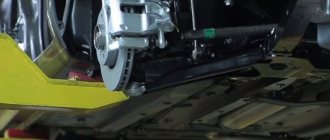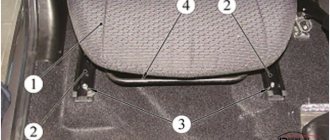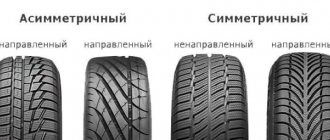↑ Determination of clearance
First, it’s worth understanding what the clearance of the Lada Vesta is. We are talking about ground clearance, that is, the distance from the surface of the earth to the lowest protruding point of the car. Since the vehicle is produced in Russia, the condition of the roads in the country was taken into account during its development. Thanks to this, the car turned out to be quite tall. But it’s worth figuring out what indicators relate to the car.
Is it possible to reduce clearance
The desire to reduce the ground clearance of the Lada Vesta SV Cross is not entirely clear. This car is purchased for difficult driving conditions. The owner usually reduces the ground clearance of a Lada not to improve technical characteristics, but to satisfy his own ambitions and beautiful photos. A certain part of car enthusiasts have their own opinion about the beauty and brutal appearance of the vehicle. They prefer down-to-earth cars that literally drag their bellies along the asphalt.
They reduce the ground clearance in two ways: they cut the springs with their own hands or purchase shorter ones - Technospring -50 mm or -30 mm.
In the first case, the financial costs will be minimal, but you need to work, in the second you will have to spend money.
If stiffer lowering springs are installed, lowering the ride height has certain advantages:
- Handling and stability at high speed are improved by increasing suspension rigidity.
- Sharper steering and lack of roll allow you to take turns at higher speeds.
- The car does not “bite” during sudden braking or stopping.
- Reducing resistance reduces fuel consumption (up to 0.5 liters per 100 km).
What are the negative reviews associated with:
- When driving over bumps and bumps, you will have to slow down, increase your vigilance, and be careful not to damage the front bumper and underbody.
- There is a risk of damage to the lower part of the doors on the curb when opening in a parking lot.
- Outside the city, on country roads, you will have to carefully choose a suitable route. In many areas of the lowered Lada Vesta, the passage may be completely closed.
- On a snowy road, the front bumper can turn into a snow bucket. Narrow arches will promote snow accumulation.
For some, a reduction is truly a measure that significantly improves technical characteristics and allows you to correct the manufacturer’s shortcomings. For others, the disadvantages that arise when reducing ground clearance are unacceptable.
↑ Standard ground clearance indicators
If you look at the documents, you can easily understand what ground clearance the Lada Vesta has. It is believed that the distance from the engine crankcase to the ground is 171 mm. If you look at the height from the engine mudguard, the ground clearance will be 144 mm. These measurements were taken on 16-inch wheels. If the car has tires of a different size, then the ground clearance will change. For example, if 15-inch wheels are installed, the distance will be 165 mm to the crankcase and 138 mm to the mudguard.
What is the distance to the ground - a loaded car is afraid of curbs
At the beginning of this article, we will give a definition of vehicle clearance - this is the gap from the ground to the bottom point of the car. The higher this indicator, the much better its all-terrain capability. Proper weight distribution of the equipment ensures stability on the track. Manufacturers of the Lada Vesta measure ground clearance in other ways. The distance of the shock absorbers and engine crankcase to the asphalt is less than recommended by the options of the manufactured vehicle. You must be careful when parking next to curbs. A loaded car sags by 3-5 centimeters.
↑ Clearance parameters
Above were the ground clearance parameters for the Lada Vesta when loading. As for an empty car, its indicator will be from 171 to 178 mm. There may be higher rates. In general, the manufacturers made sure that the sedan was quite “tall”. Otherwise, it will simply cling to the road with its bottom, which no driver will like. You can measure the distance not only to the crankcase or mudguard. For example, the clearance to the muffler is 18.7 cm.
Clearance of closest competitors
In the AvtoVAZ car lineup, the Lada Vesta is superior in ground clearance to all models except all-wheel drive. Of the foreign competitors of this class, the closest is Nissan Almera (160 mm). Further we can note: Kia Cee'd (150 mm), BMW 3 Series F30 (140 mm), Audi A1 Sportback (125 mm). A higher class car, the Peugeot 408, has a record height of 178 mm.
The consumer market did not immediately accept the Lada Vesta, but with the creation of the SW and SW Cross family station wagons, the car’s position strengthened significantly. And the ground clearance of the Lada Vesta SW Cross is such that crossovers can be envious.
↑ At full load
The concept of full load implies that the car contains a driver, passengers, and cargo. The sedan can withstand a maximum load of 400 kilograms. This is also reflected at a distance to the surface of the earth. It was already said above that when the car is fully loaded, its value will be 14.4 or 17.1 cm, depending on the location of measurement. It is important to understand that the real ground clearance of the Lada Vesta depends on exactly how loaded the car is. If there is a driver and a passenger in the car, but there is no cargo, then the ground clearance will differ from the declared one.
Sedan
The vehicle owner's manual states the following:
- Ground clearance (at full load), under the engine crankcase - 171 mm ;
- Minimum ground clearance (clearance), at full load, under the engine mudguard - 144 mm .
Gross load is the maximum permissible weight of the vehicle, which includes the weight of the curbed vehicle, the weight of the driver and passengers and the weight of the transported cargo. If we talk about the Lada Vesta, the difference between the total and curb weight is about 400 kg. Obviously, the car at full weight is used much less often than when equipped (without cargo and passengers), and accordingly Vesta’s ground clearance will be greater.
Measurements of the ground clearance of the equipped Vesta of its competitors (Solaris, Gentra, Logan and Polo sedan) were made by the Internet resource ZaRulem.
Thus, the clearance of the Lada Vesta without load is:
- for engine protection - 190 mm (205 mm for Lada Granta);
- along the overhang of the bumper - 230 mm (250 mm for the Lada Granta).
As the saying goes, “trust but verify.” We measure the ground clearance using a tape measure. Watch the video:
The muffler is securely hidden in the underbody tunnel, and the lowest point is the central part of the crankcase protection. When measuring, we got a figure of 187 mm . It is worth noting that Vesta has a more massive rear beam; it seems that it protrudes slightly relative to the bottom. But the fears were not confirmed; the ground clearance under the rear suspension beam turned out to be 191 mm.
↑ Car behavior on the road
The sufficient height of the car will definitely be appreciated by motorists living in provincial settlements. This is where severe road problems are usually observed. The high ground clearance of the Lada Vesta from AvtoVAZ allows you to minimize the risk of problems associated with this. But the long distance to the bottom also has disadvantages. It negatively affects the vehicle's handling and maneuverability while driving.
Car manufacturers have tried to reduce the negative consequences of high ground clearance. The vehicle has good steering, thanks to which the car behaves well on the road. The reduction in maneuverability is almost imperceptible.
The suspension on the car has also been carefully planned and designed. It rests on the body through a subframe. Thanks to this state of affairs, Vesta has good driving characteristics. Some compare it with foreign cars, and Lada will even give many foreign cars a head start in terms of characteristics. For example, the Nissan Almera has a height to the bottom of 165 mm. The Peugeot 408 has a ground clearance of 178 mm to the crankcase.
If we compare the parameters of Vesta with domestic analogues, then the ground clearance indicator exceeds the characteristics of other models from AvtoVAZ. There are only two cars that have slightly more ground clearance. We are talking about Kalina 2 and Largus with front-wheel drive. This is why Lada Vesta is so popular today. It is liked by drivers who drive a lot on roads that are not of very good quality.
In a word, the ground clearance of the mentioned sedan is a fairly pleasant indicator for drivers. Even at full load the machine remains quite high. This allows you to drive on uneven roads and even overcome all kinds of obstacles without any problems. It is important to understand that if the load is incomplete, the clearance value will differ from that stated in the documents. If you wish, you can take measurements yourself.
What is the real ground clearance of the Lada Vesta
Lada Vesta: Cross? We measure the ground clearance of Kalina Cross, Largus Cross and Vesta
Cars with a small height from the supporting plane to the bottom of the body are not recommended for Russian roads, since the road surface is generally not of the best quality. In this regard, domestic cars have never stood out for being too low in height. This also applies to the Lada Vesta, which is a rather tall car.
Therefore, when purchasing this car for driving on Russian roads, you need to pay attention to important technical characteristics such as Lada Vesta ground clearance or ground clearance
Lada Vesta SW Cross. Should I take it or not? Test drive, real ground clearance, acceleration 1.8 MT, trunk, off-road.
Ground clearance is the height from the plane on which the machine stands to its lowest point in the central part relative to this support. In other words, this is the ground clearance between the asphalt and the bottom plane of the car. To increase the vehicle's maneuverability in hard-to-reach places, it is necessary to increase its ground clearance. But this applies only to bad roads, since on high-quality surfaces with high speeds it needs to be reduced. This is due to the fact that the higher the car’s ground clearance, the higher its center of mass is located, which directly affects the handling and stability of the vehicle.
https://youtube.com/watch?v=DebhzD_2Y9U
How to find out the real ground clearance?
When planted, this vehicle feels better on the highway at high speeds than when raised. In most cases, the distance between the plane of the support and the bottom point of the car is indicated in millimeters
Sometimes the amount of ground clearance under the rear and front axle is important, since for rear-wheel drive cars these indicators may differ, while for front-wheel drive cars they are approximately the same
A good height between the car and the road makes it easier for the car to overcome sections of the road where there is no quality coating or it is badly damaged.
The technical characteristics of this model with a sedan body type are quite high in comparison with those of its main competitors.
According to official information, the following clearance values are determined:
when fully loaded under the engine crankcase - 171 mm; under the engine splash guard (at full load) – 144 mm; without loading under engine protection – 190 mm; under the bumper overhang (without loading) – 230 mm.
To understand what the above numbers mean, you need to understand what the full load is for the Lada Vesta. This is the sum of the mass of the car with all components, transported luggage, as well as the mass of the driver and passengers. This value is the maximum permissible for the vehicle. The difference between the full load and curb weight for the Lada is 400 kilograms.
Since the car is most often not used at full weight, the ground clearance between it and the road will be higher. The ground clearance of this model may differ slightly from what is indicated in the technical documentation due to the use of tires and rubber on wheels of different diameters.
An official AvtoVAZ source says that tires of size 185/65R15 (16) should be used. This fact should not be neglected, since the correct wheel parameters directly affect how the car will behave on the road.
A not very lowered model with a hatchback body type, the production of which is expected in the near future, will differ from the sedan body type in that its ground clearance may be slightly lower. The difference should not be big, since car sales are designed primarily for motorists in the Russian Federation.
AvtoVAZ presented a new serial version of the Lada Vesta with a station wagon body type, as well as in a cross-modification, which assumes the presence of increased ground clearance. The implementation of new products is planned in the second half of the year.











